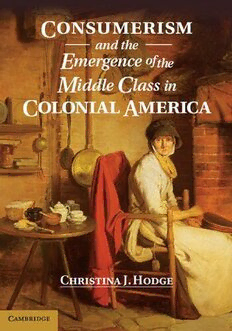
Consumerism and the Emergence of the Middle Class in Colonial America PDF
Preview Consumerism and the Emergence of the Middle Class in Colonial America
CONSUMERISM AND THE EMERGENCE OF THE MIDDLE CLASS IN COLONIAL AMERICA This interdisciplinary study presents compelling evidence for a revolu- tionaryidea:thattounderstandthehistoricalentrenchmentofgentility in America, we must understand its creation among non-elite people: colonialmiddlingsortswholaidthegroundworkforthelaterAmerican middle class. Focusing on the daily life of Widow Elizabeth Pratt, a shopkeeper from early-eighteenth-century Newport, Rhode Island, Christina J. Hodge uses material remains as a means of reconstructing notonlyhowMrs.Prattlived,butalsohowobjectsreflectshiftingclass and gender relationships in this period. Challenging the “emulation thesis,”acommonassumptionthatwealthyelitesledfashionandculture changewhilemiddlingsortsonlyfollowed,Hodgeshowshowmiddling consumers were in fact discerning cultural leaders, adopting genteel material practices earlier and more aggressively than is commonly thought.Byfocusingontheriseandemergenceofthemiddleclass,this bookbringsnewinsightsintotheevolutionofconsumerism,class,and identityincolonialAmerica.Despitethecentralimportanceofthemid- dlingsortstoculturaltransformationsoftheeighteenthcentury–includ- ingconsumerism,merchantcapitalism,andurbanization–thisisthefirst majorstudydedicatedtothematerialcultureoftheirdailylives. Christina J. Hodge is Coordinator for Academic Partnerships at the PeabodyMuseumof ArchaeologyandEthnology, Harvard University. She teaches in Museum Studies and Anthropology for the Harvard Extension School and Harvard Summer School, and she has lectured on anthropology at Harvard University as part of the Harvard Yard Archaeology Project. As a scholar-practitioner, she regularly publishes andpresentsonthearchaeologyandhistoryofHarvardUniversityand colonialNewEngland,aswellasonthePeabody’sworkwithdescendant andacademiccommunities.Hodge’sresearchfocusesonsocialarchae- ology, museum anthropology, material culture studies, and public archaeology. CONSUMERISM AND T HE EMERGENCE O F T HE MI D DL E C LA S S IN COLONIAL AMERICA Christina J. Hodge 32AvenueoftheAmericas,NewYork,NY10013–2473,USA CambridgeUniversityPressispartoftheUniversityofCambridge. ItfurtherstheUniversity’smissionbydisseminatingknowledgeinthepursuitof education,learning,andresearchatthehighestinternationallevelsofexcellence. www.cambridge.org Informationonthistitle:www.cambridge.org/9781107034396 ©ChristinaJ.Hodge2014 Thispublicationisincopyright.Subjecttostatutoryexception andtotheprovisionsofrelevantcollectivelicensingagreements, noreproductionofanypartmaytakeplacewithoutthewritten permissionofCambridgeUniversityPress. Firstpublished2014 PrintedintheUnitedStatesofAmerica AcatalogrecordforthispublicationisavailablefromtheBritishLibrary. LibraryofCongressCataloginginPublicationData Hodge,ChristinaJ. ConsumerismandtheemergenceofthemiddleclassinColonialAmerica ChristinaJ.Hodge,PeabodyMuseum,HarvardUniversity. pages cm ISBN978-1-107-03439-6(hardback) 1. Consumption(Economics)–Socialaspects–UnitedStates–History–18thcentury. 2. Middleclass–UnitedStates–Economicconditions–18thcentury. 3. Consumer behavior–UnitedStates–History–18thcentury. I. Title. HC104.H63 2014 306.30973009033–dc23 2013030946 ISBN978-1-107-03439-6Hardback CambridgeUniversityPresshasnoresponsibilityforthepersistenceoraccuracyof URLsforexternalorthird-partyInternetWebsitesreferredtointhispublication anddoesnotguaranteethatanycontentonsuchWebsitesis,orwillremain, accurateorappropriate. This book is dedicated to my mother, Janice M. Hodge, and to my father, Barry R. Hodge. contents Figures pageix Tables xii Acknowledgments xiii Preface xvii 1 Introduction 1 ApproachingtheGenteelRevolution 1 TheInterdisciplinaryArchive 8 WidowPrattandtheGenteelRevolution 16 2 ConsumingContexts 19 “AnInclinationtoFinery” 19 PracticesofTasteandSocialDistinction 27 Reflection 31 3 LivingSpaces 33 AboutTown 33 AHouseholdonSpringStreet 37 TheArchaeologyofWidowPratt:Lifeina MiddlingHousehold 40 Vignette:Dinah 63 TheMiddlingSort:GenteelLifestylesofPartible Refinement 71 4 AtTable 74 Introduction:CeramicsandSocialLife 74 CeramicsinColonialNewport 75 Dining 83 Drinking 98 Gender,Gentility,andMiddlingTastes 121 vii viii contents 5 KeepingtheShop 126 Introduction 126 Shopkeeping 127 TheFamilyUnravels:InferiorCourt,May1733, andSuperiorCourt,March1734 146 Conclusions 164 6 LegaciesoftheGenteelRevolution 167 GentilitythroughStrategicRefinement 167 LegaciesofPartibleRefinement 178 Reflection 182 AppendixA. ArchaeologicalTables 185 AppendixB. DocumentaryTables 192 AppendixC. ExpandedFigureCaptions 200 ReferencesCited 219 Index 241 figures 1.1 LithographViewofNewport,circa1740 page9 1.2 MapofRhodeIslandShowingNewport, Providence,Bristol,andCranston 10 1.3 APlanoftheTownofNewportinRhodeIsland (1777) 11 1.4 TheWoodLotPortionoftheWanton-Lyman- HazardSite 12 1.5 ArchaeologicalSitePlanofPratt’sHouseLot 13 1.6 Pratt’sPrivyduringExcavation 14 2.1 DetailfromTheTeaTable(1710) 26 3.1 PrattFamilyGenealogy 37 3.2 ElizabethPratt’sDaughter’sGravestonein NewportCommonBurialGround 39 3.3 PrerestorationPhotographofaBarnintheRear Wanton-Lyman-HazardYard 41 3.4 PostrestorationPhotographoftheRear Wanton-Lyman-HazardYard(circa1930) 41 3.5 DetailfromtheMapofNewportbyEzraStiles (circa1758) 42 3.6 DrawingoftheFennerHouse(1677) 43 3.7 WightmanHouse(circa1721) 44 3.8 SelectChamberPotFragmentsfromPratt’s Privy 46 3.9 FireplaceandStairsAnaloguesforPratt’sHome fromtheRichardsonHouse(1715) 50 3.10 FrontispiecefromTheCompleatHousewife,or, AccomplishedGentlewoman’sCompanion (Smith,1739) 52 3.11 CompleteCeramicVesselsfromthePrattPrivy 53 3.12 UtilitarianCeramicsfromPratt’sHousehold 56 3.13 PipeBowlFragmentsDatingfromPratt’s OccupationoftheWoodLot 59 3.14 GamingArtifactsfromVariousWoodLotContexts 61 ix
